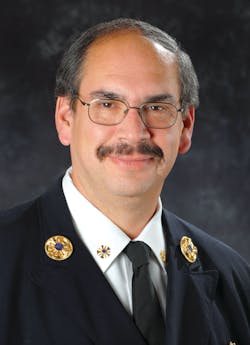AS WE GET CLOSER TO THE 10TH ANNIVERSARY of the events of 9/11, the use of new technology has brought not only the fire service, but almost every aspect of daily life to a much higher level than it was a decade ago. Seatbelts in fire and emergency apparatus have been studied, redesigned and field tested so they work, fit and are more effective today, especially with firefighter safety in mind.
In 2007, two FDNY firefighters were killed during a fire that ripped through the upper floors of the Bankers Trust Building, as it was known on 9/11 and Deutsche Bank in the following years. The building, which was damaged by the collapse of the South Tower of the World Trade Center, was being dismantled as asbestos was being removed. During the fire, dozens of Maydays were given. The radio system at the time could not keep track of all the distress calls that were being received from firefighters operating high up inside the vacant building. Recently, the FDNY has been field testing and has put into use a system to keep track of multiple Maydays if such an event should happen again. This allows the incident commander to know the unit, name and operating position of that individual in a specific fire company working that tour.
• • •
THE USE OF SOCIAL MEDIA, Facebook, Twitter, emails and YouTube have gotten many a firefighter into trouble recently. We’ve said it many times before – you can have all the fun and games you want, but when others see or read about a situation that is embarrassing not only for the individual, but for a specific fire department, then some action has to be taken. This is usually at the expense of those involved. A word to the wise: don’t do it and you won’t get into trouble. It’s that simple.
• • •
TEN YEARS AGO, THE NATION’S FIRE SERVICE was held in high regard across the land. At the time, a firefighter told me that’s bad because there is only one way to go. Where firefighters weren’t being paid enough, raises were given. Where pensions didn’t measure up, many retirement programs were improved. Where fire departments didn’t have enough money, budgets were raised, apparatus was purchased and firefighters were hired.
Today, look at the trend. No raises, reduced pensions, more years to work before retiring, firefighters laid off, fire companies browned out, fire stations closed, no hiring, fire departments consolidating, dispatch offices merging. We were at the top of the ladder, the most respected and regarded as the best service providers, still minutemen. The fire service continually does more with less, because of the caliber of the people who perform the job, day in and day out.
In this month’s Fire Politics column, “What a Difference 10 Years Can Make,” on page 20, Contributing Editor Dennis Compton writes, “Ten years ago, firefighters were on top when it came to respect, prestige and support on many fronts. Now, that reputation seems to have come under attack and shifted somewhat… If this shift is allowed to continue unchecked, there could be an irreversible change in public support for firefighters that could seriously impact the overall level of influence held by the fire service at the national, state and local levels.” How right he is.
In his EMS column, “Taking a Swipe at Fire-Based EMS,” on page 40, Contributing Editor Gary Ludwig discusses a California grand jury’s criticisms of fire-based emergency medical services. The grand jury’s report included such comments as “well-rewarded firefighters wear golden handcuffs” and “firefighters are paid for 23 hours of sitting around for one hour of work.” As they say, what a difference 10 years can make.
• • •
FOR COMMENTS AND SUGGESTIONS, please contact us at [email protected].
51?
2011 firefighter line-of-duty deaths at press time.
940
2011 residential fire fatalities at press time.






